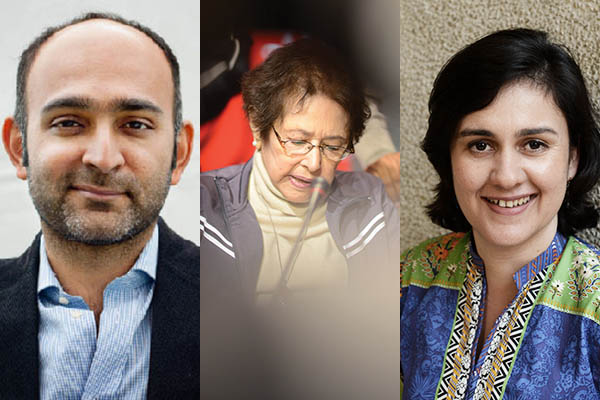By Aurangzeb Wattoo
The Colonial project brought so many bad and so many good things to colonized world and on of them is the most popular literary genre today. Novel, tracing its roots in 17th century Spanish writer Cervantes’ Don Quixote, traveled throughout the Western world and, from Fielding to Hawthorne, and Dickens to Hemingway, engulfed the imagination of book lovers with such a huge impact that all other literary genres fell from the favour of readers. Exporting the stolen treasures of colonized world and importing colonial cultural, Europeans also brought their favorite literary genre to the shores of India and Africa. Colonized world first took it with ambivalence but soon it was accepted as a wonderful tool of expression, especially in India. Many Indian writers tried their hands on novel in different languages of subcontinent and with the beginning of 20th century almost every established language has a little collection of novel. Very first attempts in writing an English novel in subcontinent can be traced in writings of Sheikh Dean Muhammad and Bankim Chandra Chattopadhaye but it was Ahmad Ali’s Twilight in Delhi (1940) which gave an international recognition to literary endeavors of Indian-English novel. After partition of in 1947, Pakistan inherited the literary traditions of Indian subcontinent and Urdu writers dominated the literary world of new-born nation. In 1950s and succeding decades though writers like Zulfiqar Ghose, who wrote The Murder of Aziz Khan (1967), made a contribution but English remained a language of “Anglophile” elite and found a very short readership. Bapsi Sidhwa, the mother of Pakistani English novel published her first novel “The Crow Eaters” in 1978 and her works continued to appear in coming years however, the literary scene of Pakistani novel as a whole, remained barren in following decades. Sara Sulehri also made a contribution with her classic memoir Meatless Days published in 1989 that presents a picture of personal and private life of the writer. As a matter of fact, it was the very last decade of 20th century when many young writers made very significant efforts in giving life to Pakistani-English novel and laid the foundations of distinctive Pakistani idiom. The veteran writer Bapsi Sidhwa who have written half a dozens of novels also published her most successful novel The Ice-candy Man in last decade of 20th century which eventually became subject of critically acclaimed Bollywood film Earth 1947. The celebrated author of some of the finest novels produced by any Pakistani writer, Kamila Shamsie, entered the literary arena with her debut novel In the City by the Sea in 1998. She later went on to publishing highly acclaimed novels including Kartography (2002), Broken Verses (2005), Home Fire (2017) and Burnt Shadows (2009). A Pakistani-British author, Shamsie deals with themes of identity, gender politics, sex, history, terrorism and many more current issues that deconstruct the Pakistani consciousness. The next entrance was Mohsin Hamid’s publication of Moth Smoke in 2000 that created quite a stir among South Asian readers. Mohsin Hamid subsequently wrote some more novels including Booker Prize Nominee The Reluctant Fundamentalist. The works of Shamsie and Mohsin Hamid opened the doors of international recognition for distinctively Pakistani works in English language and many new writers entered into literary circle. The first two decades of 21st century proved most ripe and pregnant; and writers like Muhammad Hanif, Omar Shahid Hamid,Fatima Bhutto, Nadeem Aslam, Bina Shah and Dr. Osama Siddique made real contributions to enrich the Pakistani-novel. These writers discussed different philosophical, civilizational, religious and socio-political issues in their writings and tried to pose fundamental questions which an ordinary Pakistani faced in 21st century world. They gave voices to voiceless, questioned the moral and political corruption, satirized the military dictatorship and unveiled the untouched realms of sexual world. Pakistani-English novel didn’t blindly follow the western style of expression but like many other postcolonial nations, tried to form a unique Pakistani voice. Pakistani novel’s journey from partition to 21st century globalized world is an expression of heterogeneous experiences and all those realities and experiences found their voices in works of Pakistani authors. Here is a selection of some most representing works who define different phases of turbulent history of this dynamic and complex nation and express the spirit of this “brave new world” of Pakistani fiction.
The Reluctant Fundamentalist by Mohsin Hamid (2007)
Mohsin Hamid’s magnum opus, tells us the story of a talented expatriate Pakistani and his experiences in pre and post 9/11 America. Changez, the protagonist, a young student travels to America and after graduating from Princeton finds a lucrative carrier in Underwood Samson. He falls in Love with already suffering Erica and continues to bloom until the attacks on twin towers changed everything. Changez, stripped naked at airport, quarrels with his boss returns to his native country only to become an anti-America intellectual and protestor. Hamid uses unique style of story-telling in his semi-autobiographical novel by employing the techniques of flash-back and temporal distortion. The novel is arguably most important modern book that defines the era and realities that Muslims and Pakistanis faced in American age. Mohsin Hamid’s work was first ever novel written by a Pakistani author to be nominated for prestigious Booker Prize and remained at best seller lists worldwide. Renowned filmmaker Mira Nair adopted the novel in her highly acclaimed feature film with the same title.
Ice-candy Man by Bapsi Sidhwa (1991)
The veteran writer Bapsi Sidhwa can rightly be named as Mother of Pakistani-English novel whose works have been inspiring the readers since four decades. Sidhwa’s Ice-candy Man published in 1991 still remains her greatest work. The story written in the backdrop of bloody partition of subcontinent is told by a child narrator Lenny, a Parsi girl who witnesses the lives of different characters changing with the storm following the independence from colonial rule. In this semi-autobiographical novel, Sidhwa tells us how things fell apart in the lives of working classes in wake of political decisions. The Ice-candy man, Aya, Masseur and the narrator Lenny are central characters in the novel whose lives were completely disrupted by the communal riots and their roles went under great change with changing realities. Sidhwa by using the lenses of Lenny gives a very realistic picture of that world which was filled with love and hatred, sex and violence, revenge and sacrifice and most of all the destructive consequences of colonial exodus.
Kartography by Kamila Shamsie (2002)
The award winning novel by celebrated author Kamila Shamsie was published in 2002 and immediately established Shamise’s reputation in Pakistani English Literature circles. The Guardian called it a deftly woven and provocative book and it garnered widespread critical appraisal in UK and Pakistan. Kartography tells the stories of Raheen and Karim who are separated due to political upheavals and violence in their native city, Karachi. The novel explores the themes of love, sacrifice, betrayel, identity, violence and troubled history of Pakistan. The story doesn’t follow a linear narrative and flashbacks gives us an insight into East Pakistan tragedy and its effects on characters of novel. Shortlisted for John Llewelyn Rhys Awards, this book is a personal history of troubled lives of soul-mates divided by geographical and political boundaries. Shamsie’s art of storytelling and great employment of evocative imagery has made the book one of the best modern Pakistani novel.
Our Lady of Alice Bhatti by Muhammad Hanif (2011)
Our Lady of Alice Bhatti is a novel written by Muhammad Hanif who makes a Christian nurse subject of his story and tries to unveil the realities faced by the people of different faith in Pakistani society. Alice Bhatti, daughter of a Chhoorrah, tries to cross the boundaries created by the political, religious and social codes by working in a hospital and marrying a Muslim without converting to her husband’s religion. Muhammad Hanif like Arundhati Roy, tries to give voice to the subaltern and voiceless in south Asian societies and discussed the problems and abuses faced by outcast, minorities, woman and children in 21st century. The book is full of realistic description of cosmopolitan Karachi and Hanif shows how political corruption, violence, sexual abuse, religious bigotry, institutional failure makes life in Karachi different from other parts of world. The award winning novel received overwhelming applause from domestic and overseas audience and New York Times called the book a kind of “interpreter of maladies”. New York Times in its review praised the naked portrayal of stark realities of the lives of woman and applauded the skills of Hanif to join the humour and horror in his story of Alice Bhatti. This brave and bold attempt is considered an important hallmark in development of Pakistani-English novel and also a must read for the serious reader.
The Murder of Aziz Khan by Zulfiqar Ghose (1967)
The Murder of Aziz Khan is a very important and foundational text in history of Pakistani-English literature which tells us a poignant story of a traditional lord owner Aziz Khan and decline of his fortunes. This masterpiece is built upon social reality and puts its characters is historical struggle between capitalist bourgeoisie and traditional farming clans. Shah Brothers representing industrial class eyes on Aziz Khan’s 70 acres land and later tries to save his existence and honour by refusing to sale his land. The story unveils the corruption followed the independence and decline of moral values in rich urban classes. The novel is set in rural Punjab and gives us realistic picture of social political financial and emotional landscape of its characters.The novel is frequently taught in Pakistani-English literature course in Pakistani universities and an Indian filmmaker also adapted it for a critically acclaimed movie in 2008.
Home Fire by Kamila Shamsie (2017)
Home Fire, long-listed for Booker Prize, is undeniably most promising work of decade by any Pakistani writer. Shamsie won unanimous applause for her skills of storytelling and producing a work describing the torments of his generation. Winner of Woman prize for fiction, Home Fire was also included in 100 most influential books by BBC. Shamsie wrote this novel in backdrop of second wave of international terrorism and tried to reimagine the story of Sophocles Antigone. In contemporary settings novel deals with the struggles of British-Muslim family, Pashas, who suffers from political and cultural clashes of Western and Muslim values. Their struggle becomes more painful when Parvaiz, the only male in the family joins ISIS to follow his fathers lineage and consequently dies while in custody of English officials. Aneeka, the twin sister of Parvaiz, tries to bring back his body for proper burial but fails to do so. The novel is experimental in its narrative and follows the free indirect discourse. The novel is set in five different locations including London, Amethyst, New York, Raqqa and Karachi.
Moth Smoke by Mohsin Hamid (2000)
The debut novel by Mohsin Hamid Moth Smoke created quite a storm on literary arena of South Asian fiction and heralded the entrance of most promising author of our generation. Moth Smoke set in Lahore starts with an event featuring Shah Jehan, the Mughal emporor who discovered that his son Aurangzeb would be the heir of his throne. Shah Jehan loved his son Dara more than Aurangzeb and returned disappointed. The scene shifts to Lahore, once-capital of Mughal Empire, and the characters of Ozi and Daru are introduced. The Lahore of Ozi and Daru is filled with drugs, sexual perversion, crime,jealousy, betrayal and hatred and modernity is replacing the traditional values especially in urban spaces. The novel unfolds its events and we find Ozi, the rich-bourgeois killing a boy in road accident and avoiding any punishment while on the other hand Daru, Ozi’s friend is hanging with his friend’s wife. Moth Smoke, the seminal work by Hamid, set new standards in Pakistani fiction and gave a unique and pure picture of Pakistani-urban society. Moth Smoke received overwhelming applause with its first publication and later adopted by a Pakistani filmmaker.
Maps For Lost Lovers by Nadeem Aslam (2004)
Nadeem Aslam’s highly acclaimed Maps For Lost Lovers is a novel that tells us about the problems faced by the working class immigrants settled in London. Dasht e Tanhai is a locality of immigrants Muslims in London where most of the action takes place and doomed love affair between Jugnu and Chanda meets its sad end. Nadeem Aslam tries to bring out the realities faced by these immigrants who are caught “in between”. The story is told through the voices of Shams and Kaukab who differed widely in their views about the relationship between Jugnu and Chanda and held opposite world view despite living in same house. Both Jugnu and Chanda disappear but later police discovers that Chanda’s brothers murdered both of them to save their honour. The novel tells us about the traditional beliefs held by Pakistani immigrants and their struggle to survive in a culture where they think that everything is falling apart. Maps For Lost Lovers, the novel that took 11 years of writer’s life, is surely a great read to understand the dilemma and complexity of lives of Pakistani diaspora living in West.
The Prisoner by Omar Shahid Hamid (2013)
The Prisoner is debut novel of cop-turned-writer Omar Shahid Hamid who tells us a story originated from his services in Karachi police. The Prisoner is a novel set in Karachi and deals with the issues of terrorism, corruption, violence and weakened justice system. “A gripping portrayal of a casually corrupt city” according to New York Times, Omar Shahid Hamid in his story gives us a very realistic and minute picture of crime and punishment in Karachi. The story starts with abduction of an American journalist days before the visit of President of United States and kidnappers declare to kill him on Christmas day. Constantine D’seouza the Christian cop, with the help of Akbar Khan tries to save the honour of country by rescuing the journalist. The ruling militant party and military agencies jump into circus with all their energies to win the race. ”A ruling thriller” according to The Hindu, The Prisoner is a bold attempt by a Pakistani writer to write a crime novel. The novel garnered great applause from both critics and audience and surely it is a must read for a new reader.
Snuffing Out the Moon by Osama Siddique (2017)
Dr. Osama Siddique’s debut but innovative work Snuffing Out The Moon is scattered over centuries of transition and development of human civilization and produce some very fundamental questions regarding existence and doom, freedom and tyranny, assent and dissent, doubt and belief. The story takes a beginning from 2084 BCE in Indus Valley Civilization and travels across the centuries and ends in 2084 CE. The narrative is extended to more than 4000 years and writer gives us a fragmented and episodic work to brood over it. The writer’s imagination and vision is fertile enough to look at past to understand the present and to predict the future.” A challenging and thought provoking read” according to Shashi Throor, the novel invites our imagination to visit the Mohenjudro and contemporary Lahore and writer tells us our history with an insight into problems and questions faced by human beings living in different ages. This experimental work by Osama Siddique is also a testimony of great development and potential of Pakistani fiction.




